HRM Practices Report: Workforce Planning, Recruitment, Legislation
VerifiedAdded on 2020/06/04
|19
|5724
|50
Report
AI Summary
This report provides a comprehensive overview of Human Resource Management (HRM) functions and practices within the context of workforce planning, recruitment, employee relations, and employment legislation. It examines the purpose of HRM in workforce planning, analyzes the strengths and weaknesses of different recruitment approaches, and evaluates the benefits and effectiveness of various HRM practices for both employers and employees. The report also highlights the importance of employee relations and the impact of employment legislation on decision-making within organizations like Woodhill College, TESCO, and ITV. Furthermore, it delves into the application of HRM practices, including job specifications and job descriptions, and discusses various methods for advertising job vacancies and attracting potential candidates. The document concludes by emphasizing the critical role of HRM in enhancing employee performance, productivity, and overall organizational success.

HUMAN RESOURCE
MANAGEMENT
MANAGEMENT
Paraphrase This Document
Need a fresh take? Get an instant paraphrase of this document with our AI Paraphraser
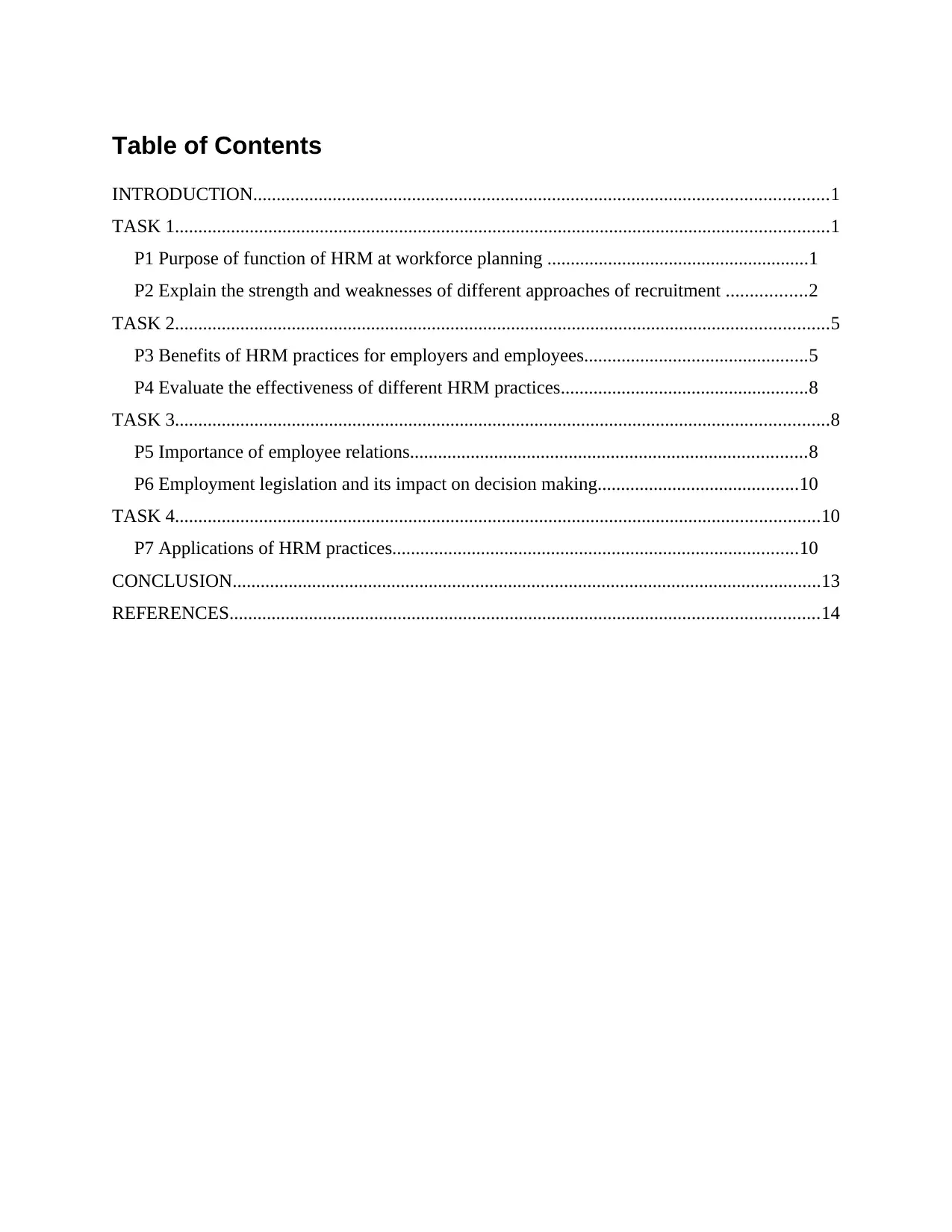
Table of Contents
INTRODUCTION...........................................................................................................................1
TASK 1............................................................................................................................................1
P1 Purpose of function of HRM at workforce planning ........................................................1
P2 Explain the strength and weaknesses of different approaches of recruitment .................2
TASK 2............................................................................................................................................5
P3 Benefits of HRM practices for employers and employees................................................5
P4 Evaluate the effectiveness of different HRM practices.....................................................8
TASK 3............................................................................................................................................8
P5 Importance of employee relations.....................................................................................8
P6 Employment legislation and its impact on decision making...........................................10
TASK 4..........................................................................................................................................10
P7 Applications of HRM practices.......................................................................................10
CONCLUSION..............................................................................................................................13
REFERENCES..............................................................................................................................14
INTRODUCTION...........................................................................................................................1
TASK 1............................................................................................................................................1
P1 Purpose of function of HRM at workforce planning ........................................................1
P2 Explain the strength and weaknesses of different approaches of recruitment .................2
TASK 2............................................................................................................................................5
P3 Benefits of HRM practices for employers and employees................................................5
P4 Evaluate the effectiveness of different HRM practices.....................................................8
TASK 3............................................................................................................................................8
P5 Importance of employee relations.....................................................................................8
P6 Employment legislation and its impact on decision making...........................................10
TASK 4..........................................................................................................................................10
P7 Applications of HRM practices.......................................................................................10
CONCLUSION..............................................................................................................................13
REFERENCES..............................................................................................................................14
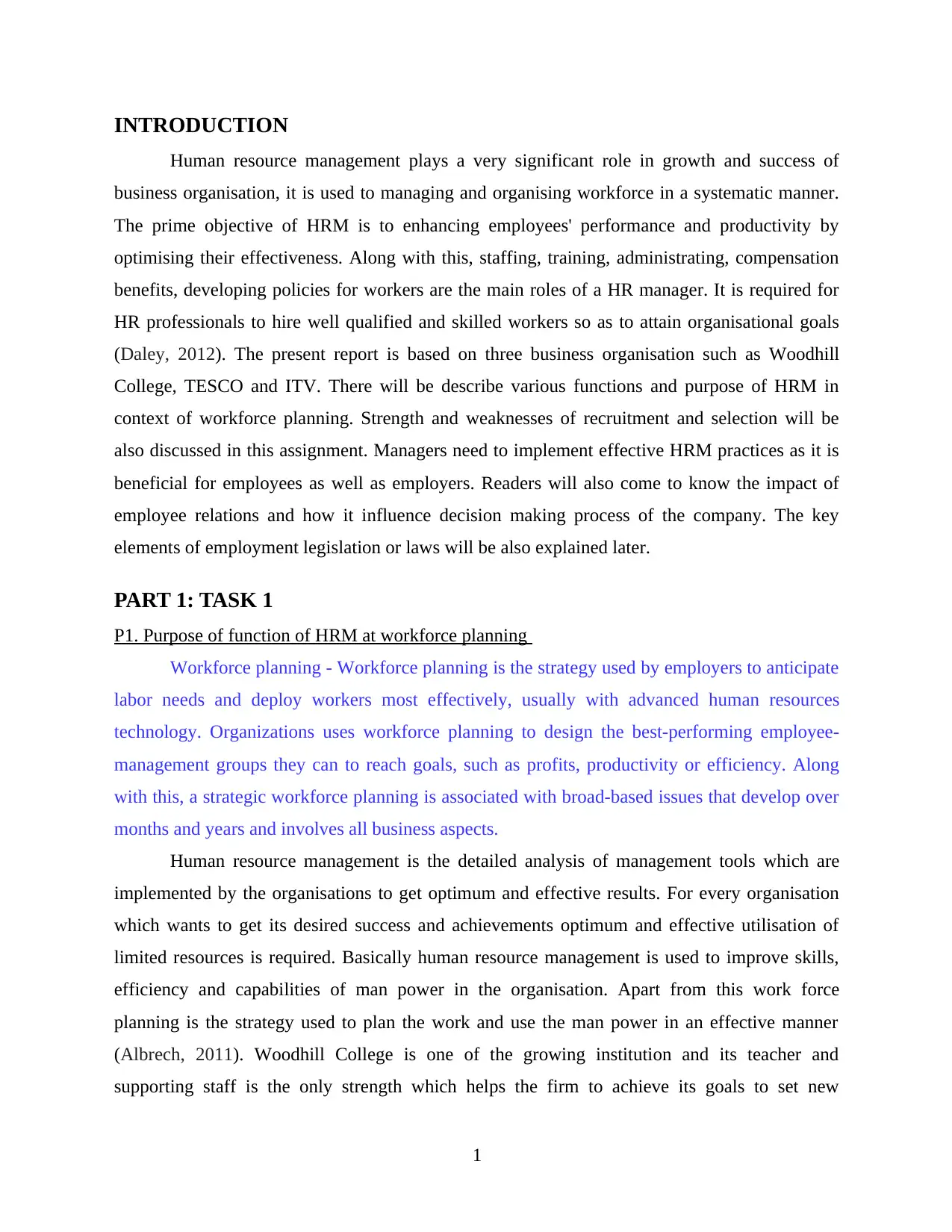
INTRODUCTION
Human resource management plays a very significant role in growth and success of
business organisation, it is used to managing and organising workforce in a systematic manner.
The prime objective of HRM is to enhancing employees' performance and productivity by
optimising their effectiveness. Along with this, staffing, training, administrating, compensation
benefits, developing policies for workers are the main roles of a HR manager. It is required for
HR professionals to hire well qualified and skilled workers so as to attain organisational goals
(Daley, 2012). The present report is based on three business organisation such as Woodhill
College, TESCO and ITV. There will be describe various functions and purpose of HRM in
context of workforce planning. Strength and weaknesses of recruitment and selection will be
also discussed in this assignment. Managers need to implement effective HRM practices as it is
beneficial for employees as well as employers. Readers will also come to know the impact of
employee relations and how it influence decision making process of the company. The key
elements of employment legislation or laws will be also explained later.
PART 1: TASK 1
P1. Purpose of function of HRM at workforce planning
Workforce planning - Workforce planning is the strategy used by employers to anticipate
labor needs and deploy workers most effectively, usually with advanced human resources
technology. Organizations uses workforce planning to design the best-performing employee-
management groups they can to reach goals, such as profits, productivity or efficiency. Along
with this, a strategic workforce planning is associated with broad-based issues that develop over
months and years and involves all business aspects.
Human resource management is the detailed analysis of management tools which are
implemented by the organisations to get optimum and effective results. For every organisation
which wants to get its desired success and achievements optimum and effective utilisation of
limited resources is required. Basically human resource management is used to improve skills,
efficiency and capabilities of man power in the organisation. Apart from this work force
planning is the strategy used to plan the work and use the man power in an effective manner
(Albrech, 2011). Woodhill College is one of the growing institution and its teacher and
supporting staff is the only strength which helps the firm to achieve its goals to set new
1
Human resource management plays a very significant role in growth and success of
business organisation, it is used to managing and organising workforce in a systematic manner.
The prime objective of HRM is to enhancing employees' performance and productivity by
optimising their effectiveness. Along with this, staffing, training, administrating, compensation
benefits, developing policies for workers are the main roles of a HR manager. It is required for
HR professionals to hire well qualified and skilled workers so as to attain organisational goals
(Daley, 2012). The present report is based on three business organisation such as Woodhill
College, TESCO and ITV. There will be describe various functions and purpose of HRM in
context of workforce planning. Strength and weaknesses of recruitment and selection will be
also discussed in this assignment. Managers need to implement effective HRM practices as it is
beneficial for employees as well as employers. Readers will also come to know the impact of
employee relations and how it influence decision making process of the company. The key
elements of employment legislation or laws will be also explained later.
PART 1: TASK 1
P1. Purpose of function of HRM at workforce planning
Workforce planning - Workforce planning is the strategy used by employers to anticipate
labor needs and deploy workers most effectively, usually with advanced human resources
technology. Organizations uses workforce planning to design the best-performing employee-
management groups they can to reach goals, such as profits, productivity or efficiency. Along
with this, a strategic workforce planning is associated with broad-based issues that develop over
months and years and involves all business aspects.
Human resource management is the detailed analysis of management tools which are
implemented by the organisations to get optimum and effective results. For every organisation
which wants to get its desired success and achievements optimum and effective utilisation of
limited resources is required. Basically human resource management is used to improve skills,
efficiency and capabilities of man power in the organisation. Apart from this work force
planning is the strategy used to plan the work and use the man power in an effective manner
(Albrech, 2011). Woodhill College is one of the growing institution and its teacher and
supporting staff is the only strength which helps the firm to achieve its goals to set new
1
⊘ This is a preview!⊘
Do you want full access?
Subscribe today to unlock all pages.

Trusted by 1+ million students worldwide
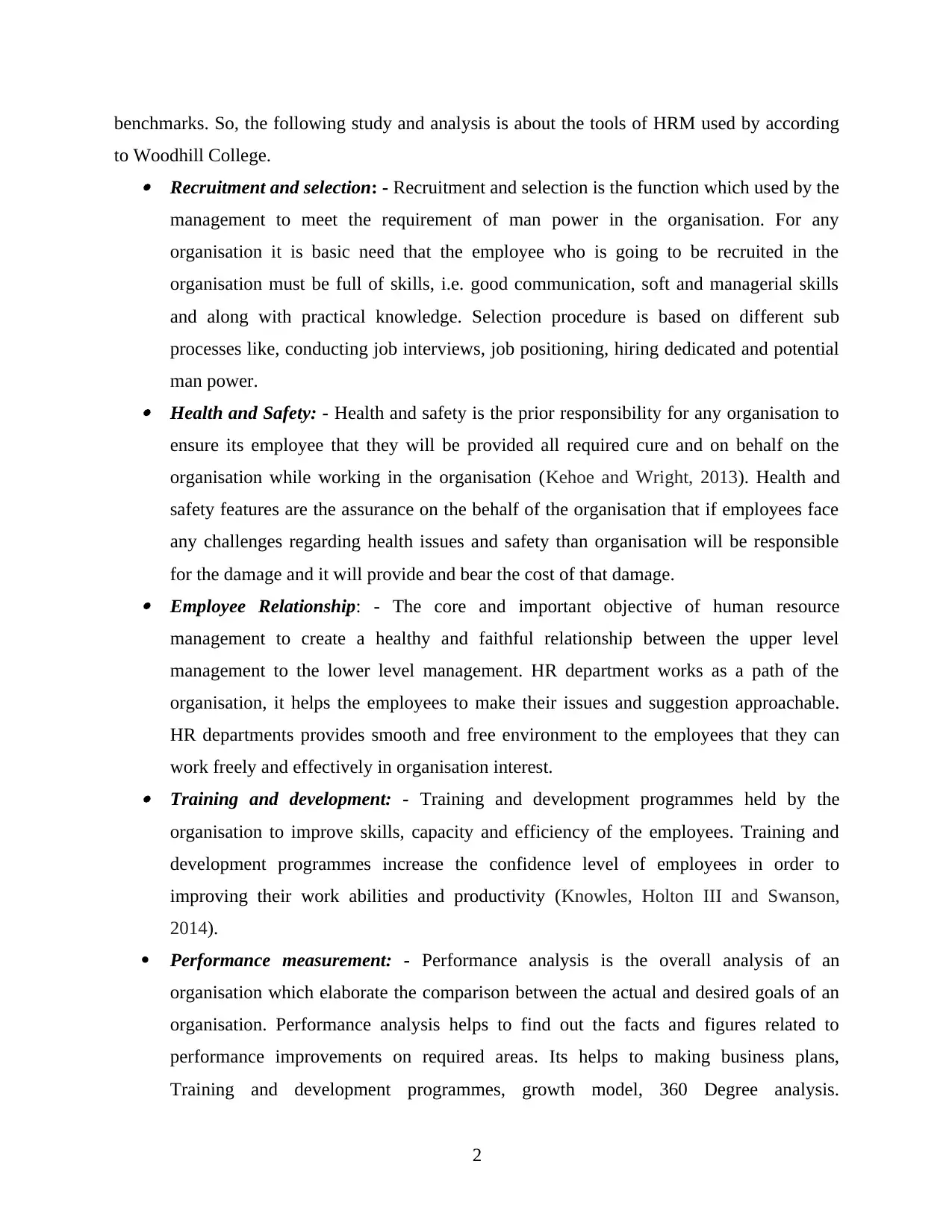
benchmarks. So, the following study and analysis is about the tools of HRM used by according
to Woodhill College. Recruitment and selection: - Recruitment and selection is the function which used by the
management to meet the requirement of man power in the organisation. For any
organisation it is basic need that the employee who is going to be recruited in the
organisation must be full of skills, i.e. good communication, soft and managerial skills
and along with practical knowledge. Selection procedure is based on different sub
processes like, conducting job interviews, job positioning, hiring dedicated and potential
man power. Health and Safety: - Health and safety is the prior responsibility for any organisation to
ensure its employee that they will be provided all required cure and on behalf on the
organisation while working in the organisation (Kehoe and Wright, 2013). Health and
safety features are the assurance on the behalf of the organisation that if employees face
any challenges regarding health issues and safety than organisation will be responsible
for the damage and it will provide and bear the cost of that damage. Employee Relationship: - The core and important objective of human resource
management to create a healthy and faithful relationship between the upper level
management to the lower level management. HR department works as a path of the
organisation, it helps the employees to make their issues and suggestion approachable.
HR departments provides smooth and free environment to the employees that they can
work freely and effectively in organisation interest. Training and development: - Training and development programmes held by the
organisation to improve skills, capacity and efficiency of the employees. Training and
development programmes increase the confidence level of employees in order to
improving their work abilities and productivity (Knowles, Holton III and Swanson,
2014).
Performance measurement: - Performance analysis is the overall analysis of an
organisation which elaborate the comparison between the actual and desired goals of an
organisation. Performance analysis helps to find out the facts and figures related to
performance improvements on required areas. Its helps to making business plans,
Training and development programmes, growth model, 360 Degree analysis.
2
to Woodhill College. Recruitment and selection: - Recruitment and selection is the function which used by the
management to meet the requirement of man power in the organisation. For any
organisation it is basic need that the employee who is going to be recruited in the
organisation must be full of skills, i.e. good communication, soft and managerial skills
and along with practical knowledge. Selection procedure is based on different sub
processes like, conducting job interviews, job positioning, hiring dedicated and potential
man power. Health and Safety: - Health and safety is the prior responsibility for any organisation to
ensure its employee that they will be provided all required cure and on behalf on the
organisation while working in the organisation (Kehoe and Wright, 2013). Health and
safety features are the assurance on the behalf of the organisation that if employees face
any challenges regarding health issues and safety than organisation will be responsible
for the damage and it will provide and bear the cost of that damage. Employee Relationship: - The core and important objective of human resource
management to create a healthy and faithful relationship between the upper level
management to the lower level management. HR department works as a path of the
organisation, it helps the employees to make their issues and suggestion approachable.
HR departments provides smooth and free environment to the employees that they can
work freely and effectively in organisation interest. Training and development: - Training and development programmes held by the
organisation to improve skills, capacity and efficiency of the employees. Training and
development programmes increase the confidence level of employees in order to
improving their work abilities and productivity (Knowles, Holton III and Swanson,
2014).
Performance measurement: - Performance analysis is the overall analysis of an
organisation which elaborate the comparison between the actual and desired goals of an
organisation. Performance analysis helps to find out the facts and figures related to
performance improvements on required areas. Its helps to making business plans,
Training and development programmes, growth model, 360 Degree analysis.
2
Paraphrase This Document
Need a fresh take? Get an instant paraphrase of this document with our AI Paraphraser
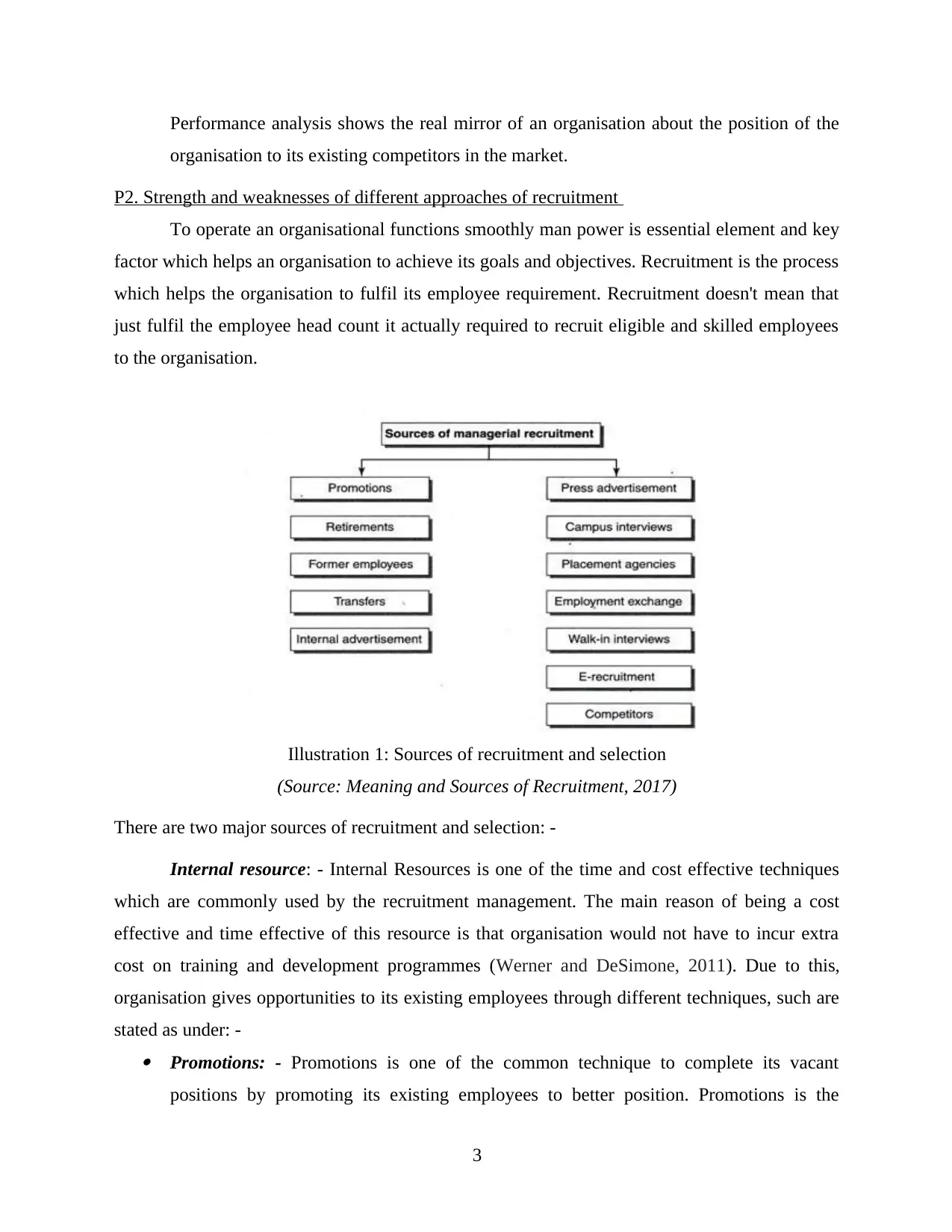
Performance analysis shows the real mirror of an organisation about the position of the
organisation to its existing competitors in the market.
P2. Strength and weaknesses of different approaches of recruitment
To operate an organisational functions smoothly man power is essential element and key
factor which helps an organisation to achieve its goals and objectives. Recruitment is the process
which helps the organisation to fulfil its employee requirement. Recruitment doesn't mean that
just fulfil the employee head count it actually required to recruit eligible and skilled employees
to the organisation.
(Source: Meaning and Sources of Recruitment, 2017)
There are two major sources of recruitment and selection: -
Internal resource: - Internal Resources is one of the time and cost effective techniques
which are commonly used by the recruitment management. The main reason of being a cost
effective and time effective of this resource is that organisation would not have to incur extra
cost on training and development programmes (Werner and DeSimone, 2011). Due to this,
organisation gives opportunities to its existing employees through different techniques, such are
stated as under: - Promotions: - Promotions is one of the common technique to complete its vacant
positions by promoting its existing employees to better position. Promotions is the
3
Illustration 1: Sources of recruitment and selection
organisation to its existing competitors in the market.
P2. Strength and weaknesses of different approaches of recruitment
To operate an organisational functions smoothly man power is essential element and key
factor which helps an organisation to achieve its goals and objectives. Recruitment is the process
which helps the organisation to fulfil its employee requirement. Recruitment doesn't mean that
just fulfil the employee head count it actually required to recruit eligible and skilled employees
to the organisation.
(Source: Meaning and Sources of Recruitment, 2017)
There are two major sources of recruitment and selection: -
Internal resource: - Internal Resources is one of the time and cost effective techniques
which are commonly used by the recruitment management. The main reason of being a cost
effective and time effective of this resource is that organisation would not have to incur extra
cost on training and development programmes (Werner and DeSimone, 2011). Due to this,
organisation gives opportunities to its existing employees through different techniques, such are
stated as under: - Promotions: - Promotions is one of the common technique to complete its vacant
positions by promoting its existing employees to better position. Promotions is the
3
Illustration 1: Sources of recruitment and selection
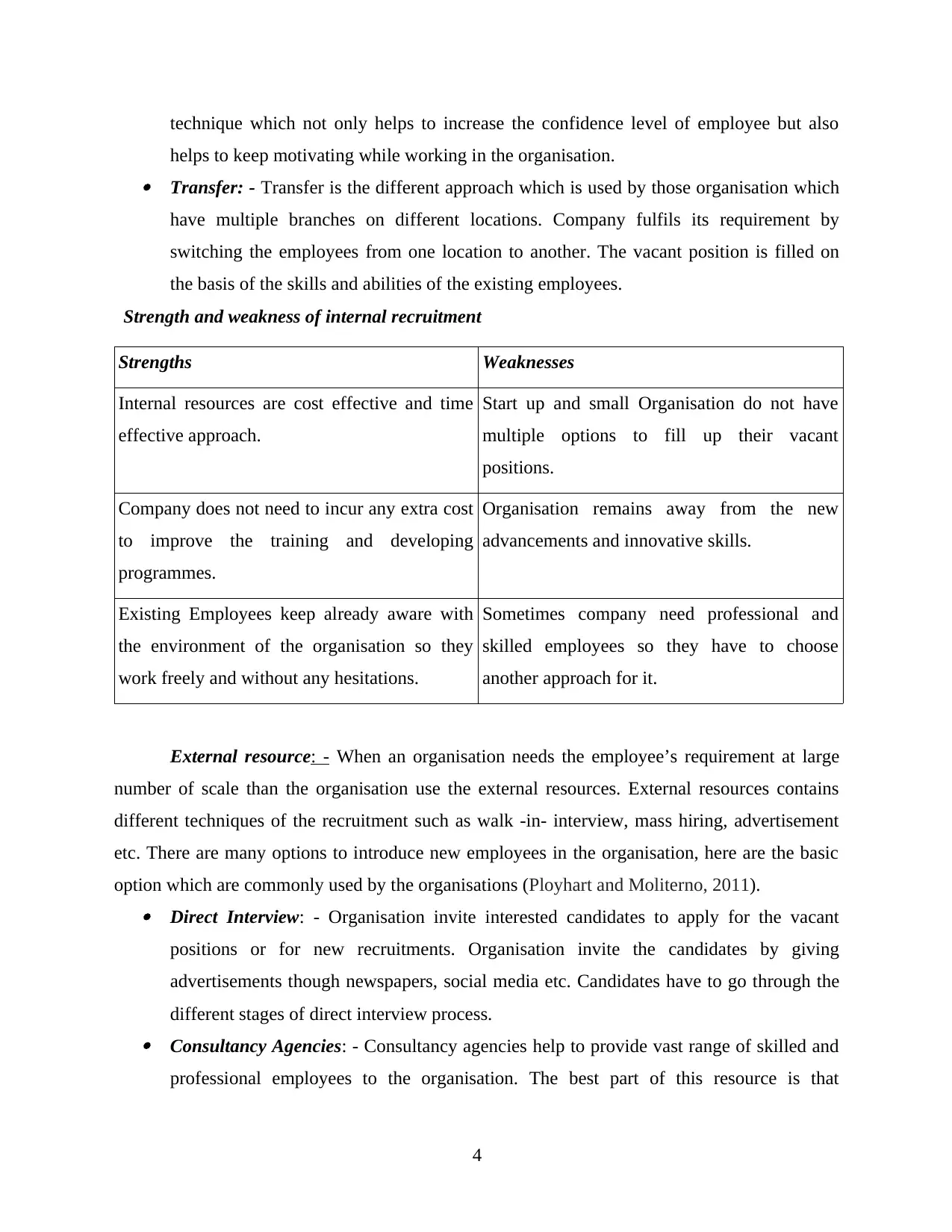
technique which not only helps to increase the confidence level of employee but also
helps to keep motivating while working in the organisation. Transfer: - Transfer is the different approach which is used by those organisation which
have multiple branches on different locations. Company fulfils its requirement by
switching the employees from one location to another. The vacant position is filled on
the basis of the skills and abilities of the existing employees.
Strength and weakness of internal recruitment
Strengths Weaknesses
Internal resources are cost effective and time
effective approach.
Start up and small Organisation do not have
multiple options to fill up their vacant
positions.
Company does not need to incur any extra cost
to improve the training and developing
programmes.
Organisation remains away from the new
advancements and innovative skills.
Existing Employees keep already aware with
the environment of the organisation so they
work freely and without any hesitations.
Sometimes company need professional and
skilled employees so they have to choose
another approach for it.
External resource: - When an organisation needs the employee’s requirement at large
number of scale than the organisation use the external resources. External resources contains
different techniques of the recruitment such as walk -in- interview, mass hiring, advertisement
etc. There are many options to introduce new employees in the organisation, here are the basic
option which are commonly used by the organisations (Ployhart and Moliterno, 2011). Direct Interview: - Organisation invite interested candidates to apply for the vacant
positions or for new recruitments. Organisation invite the candidates by giving
advertisements though newspapers, social media etc. Candidates have to go through the
different stages of direct interview process. Consultancy Agencies: - Consultancy agencies help to provide vast range of skilled and
professional employees to the organisation. The best part of this resource is that
4
helps to keep motivating while working in the organisation. Transfer: - Transfer is the different approach which is used by those organisation which
have multiple branches on different locations. Company fulfils its requirement by
switching the employees from one location to another. The vacant position is filled on
the basis of the skills and abilities of the existing employees.
Strength and weakness of internal recruitment
Strengths Weaknesses
Internal resources are cost effective and time
effective approach.
Start up and small Organisation do not have
multiple options to fill up their vacant
positions.
Company does not need to incur any extra cost
to improve the training and developing
programmes.
Organisation remains away from the new
advancements and innovative skills.
Existing Employees keep already aware with
the environment of the organisation so they
work freely and without any hesitations.
Sometimes company need professional and
skilled employees so they have to choose
another approach for it.
External resource: - When an organisation needs the employee’s requirement at large
number of scale than the organisation use the external resources. External resources contains
different techniques of the recruitment such as walk -in- interview, mass hiring, advertisement
etc. There are many options to introduce new employees in the organisation, here are the basic
option which are commonly used by the organisations (Ployhart and Moliterno, 2011). Direct Interview: - Organisation invite interested candidates to apply for the vacant
positions or for new recruitments. Organisation invite the candidates by giving
advertisements though newspapers, social media etc. Candidates have to go through the
different stages of direct interview process. Consultancy Agencies: - Consultancy agencies help to provide vast range of skilled and
professional employees to the organisation. The best part of this resource is that
4
⊘ This is a preview!⊘
Do you want full access?
Subscribe today to unlock all pages.

Trusted by 1+ million students worldwide
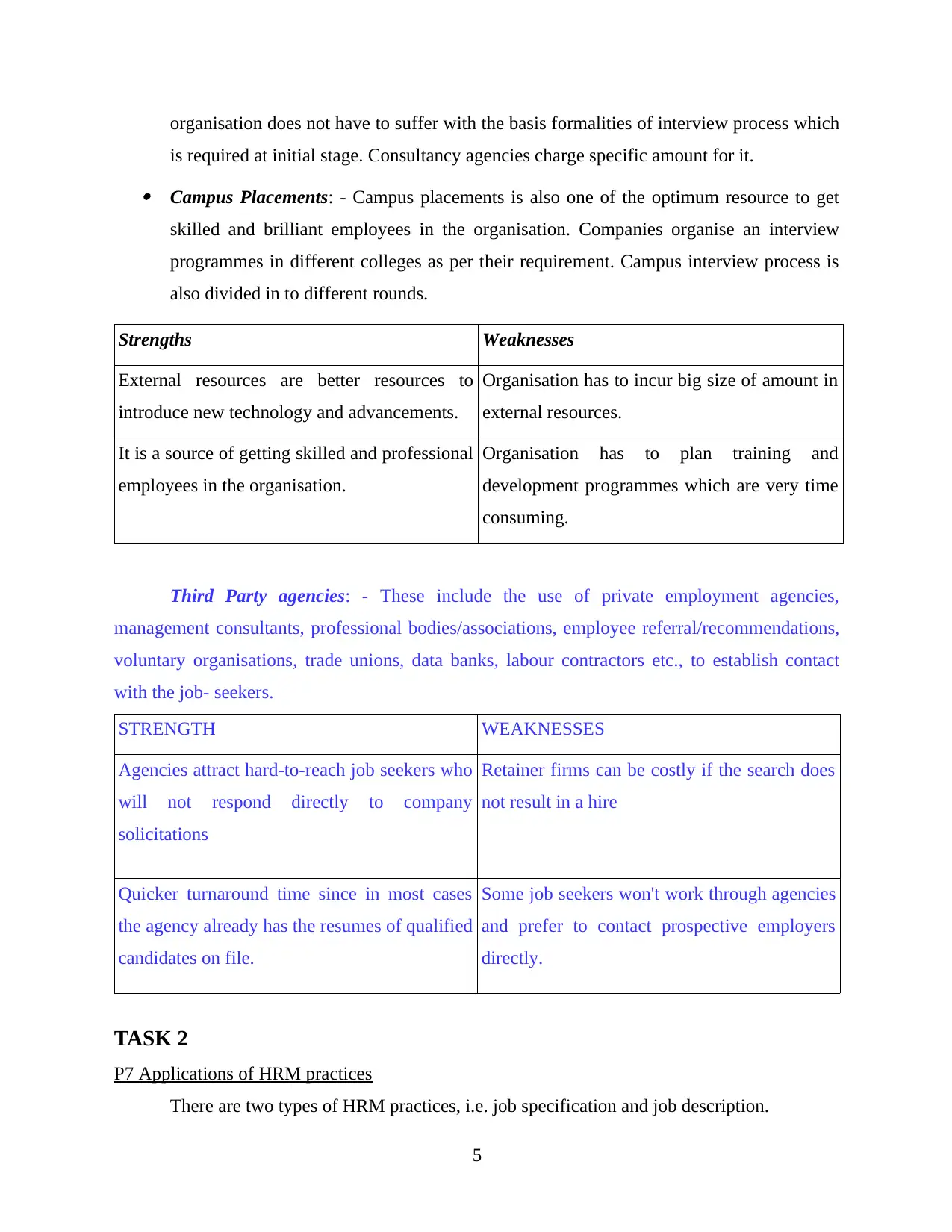
organisation does not have to suffer with the basis formalities of interview process which
is required at initial stage. Consultancy agencies charge specific amount for it. Campus Placements: - Campus placements is also one of the optimum resource to get
skilled and brilliant employees in the organisation. Companies organise an interview
programmes in different colleges as per their requirement. Campus interview process is
also divided in to different rounds.
Strengths Weaknesses
External resources are better resources to
introduce new technology and advancements.
Organisation has to incur big size of amount in
external resources.
It is a source of getting skilled and professional
employees in the organisation.
Organisation has to plan training and
development programmes which are very time
consuming.
Third Party agencies: - These include the use of private employment agencies,
management consultants, professional bodies/associations, employee referral/recommendations,
voluntary organisations, trade unions, data banks, labour contractors etc., to establish contact
with the job- seekers.
STRENGTH WEAKNESSES
Agencies attract hard-to-reach job seekers who
will not respond directly to company
solicitations
Retainer firms can be costly if the search does
not result in a hire
Quicker turnaround time since in most cases
the agency already has the resumes of qualified
candidates on file.
Some job seekers won't work through agencies
and prefer to contact prospective employers
directly.
TASK 2
P7 Applications of HRM practices
There are two types of HRM practices, i.e. job specification and job description.
5
is required at initial stage. Consultancy agencies charge specific amount for it. Campus Placements: - Campus placements is also one of the optimum resource to get
skilled and brilliant employees in the organisation. Companies organise an interview
programmes in different colleges as per their requirement. Campus interview process is
also divided in to different rounds.
Strengths Weaknesses
External resources are better resources to
introduce new technology and advancements.
Organisation has to incur big size of amount in
external resources.
It is a source of getting skilled and professional
employees in the organisation.
Organisation has to plan training and
development programmes which are very time
consuming.
Third Party agencies: - These include the use of private employment agencies,
management consultants, professional bodies/associations, employee referral/recommendations,
voluntary organisations, trade unions, data banks, labour contractors etc., to establish contact
with the job- seekers.
STRENGTH WEAKNESSES
Agencies attract hard-to-reach job seekers who
will not respond directly to company
solicitations
Retainer firms can be costly if the search does
not result in a hire
Quicker turnaround time since in most cases
the agency already has the resumes of qualified
candidates on file.
Some job seekers won't work through agencies
and prefer to contact prospective employers
directly.
TASK 2
P7 Applications of HRM practices
There are two types of HRM practices, i.e. job specification and job description.
5
Paraphrase This Document
Need a fresh take? Get an instant paraphrase of this document with our AI Paraphraser
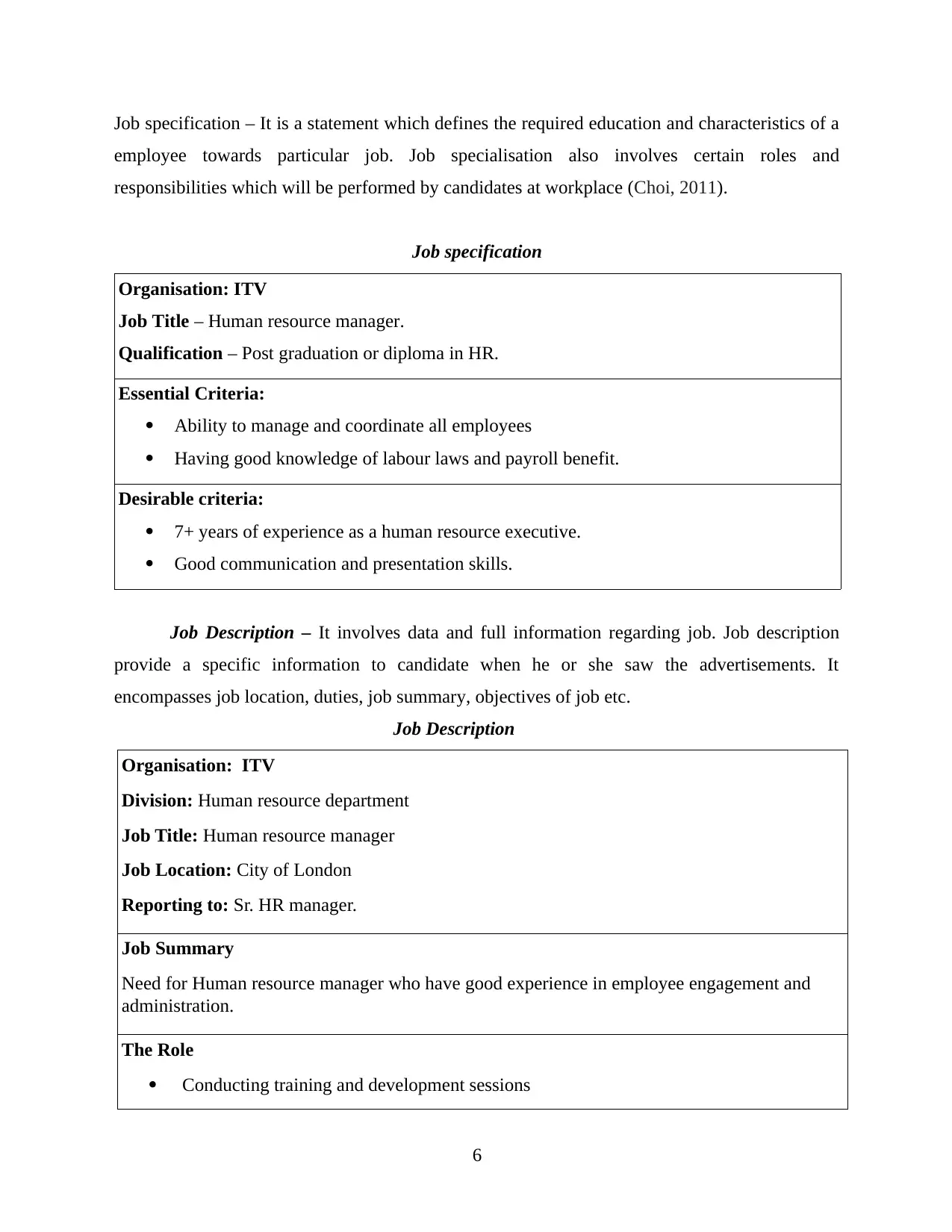
Job specification – It is a statement which defines the required education and characteristics of a
employee towards particular job. Job specialisation also involves certain roles and
responsibilities which will be performed by candidates at workplace (Choi, 2011).
Job specification
Organisation: ITV
Job Title – Human resource manager.
Qualification – Post graduation or diploma in HR.
Essential Criteria:
Ability to manage and coordinate all employees
Having good knowledge of labour laws and payroll benefit.
Desirable criteria:
7+ years of experience as a human resource executive.
Good communication and presentation skills.
Job Description – It involves data and full information regarding job. Job description
provide a specific information to candidate when he or she saw the advertisements. It
encompasses job location, duties, job summary, objectives of job etc.
Job Description
Organisation: ITV
Division: Human resource department
Job Title: Human resource manager
Job Location: City of London
Reporting to: Sr. HR manager.
Job Summary
Need for Human resource manager who have good experience in employee engagement and
administration.
The Role
Conducting training and development sessions
6
employee towards particular job. Job specialisation also involves certain roles and
responsibilities which will be performed by candidates at workplace (Choi, 2011).
Job specification
Organisation: ITV
Job Title – Human resource manager.
Qualification – Post graduation or diploma in HR.
Essential Criteria:
Ability to manage and coordinate all employees
Having good knowledge of labour laws and payroll benefit.
Desirable criteria:
7+ years of experience as a human resource executive.
Good communication and presentation skills.
Job Description – It involves data and full information regarding job. Job description
provide a specific information to candidate when he or she saw the advertisements. It
encompasses job location, duties, job summary, objectives of job etc.
Job Description
Organisation: ITV
Division: Human resource department
Job Title: Human resource manager
Job Location: City of London
Reporting to: Sr. HR manager.
Job Summary
Need for Human resource manager who have good experience in employee engagement and
administration.
The Role
Conducting training and development sessions
6
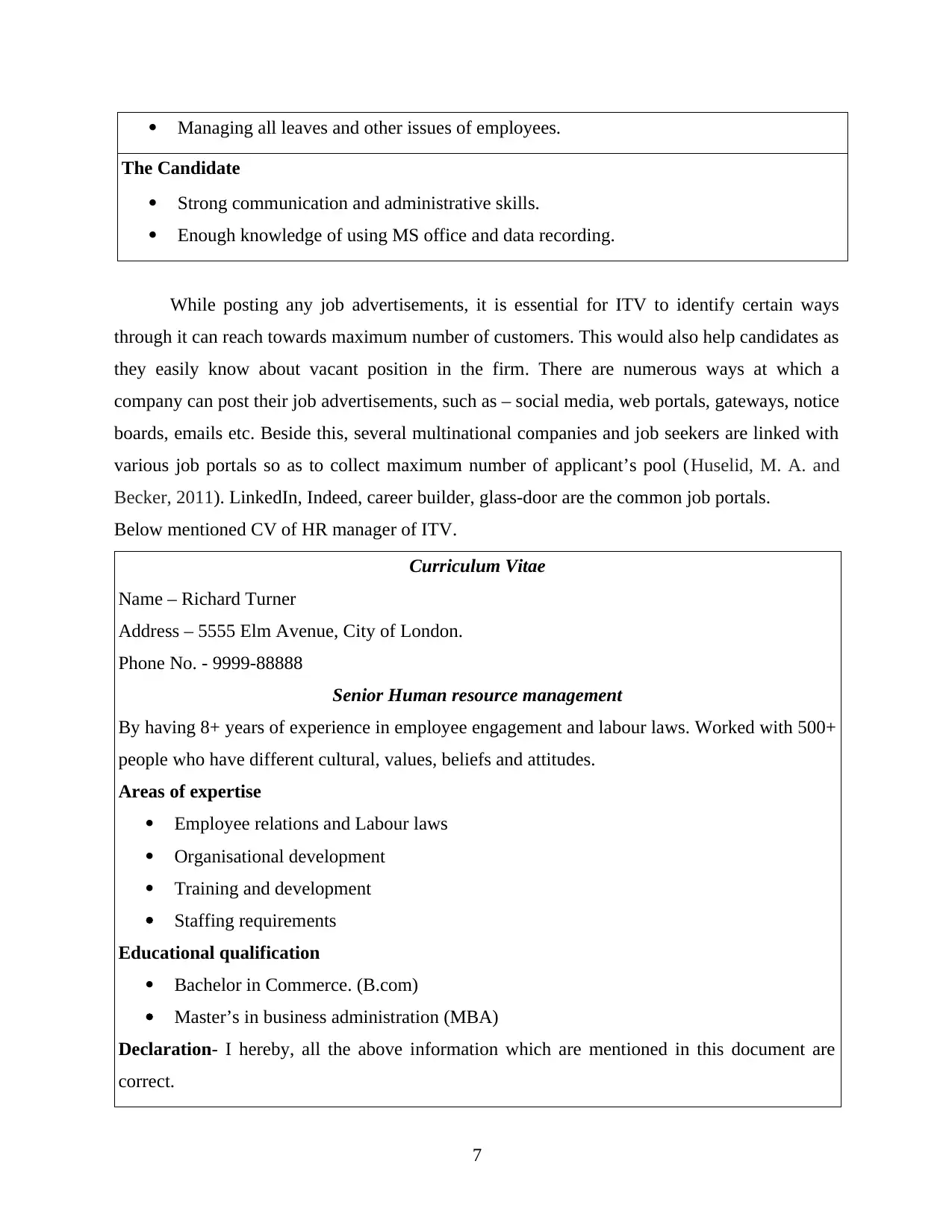
Managing all leaves and other issues of employees.
The Candidate
Strong communication and administrative skills.
Enough knowledge of using MS office and data recording.
While posting any job advertisements, it is essential for ITV to identify certain ways
through it can reach towards maximum number of customers. This would also help candidates as
they easily know about vacant position in the firm. There are numerous ways at which a
company can post their job advertisements, such as – social media, web portals, gateways, notice
boards, emails etc. Beside this, several multinational companies and job seekers are linked with
various job portals so as to collect maximum number of applicant’s pool (Huselid, M. A. and
Becker, 2011). LinkedIn, Indeed, career builder, glass-door are the common job portals.
Below mentioned CV of HR manager of ITV.
Curriculum Vitae
Name – Richard Turner
Address – 5555 Elm Avenue, City of London.
Phone No. - 9999-88888
Senior Human resource management
By having 8+ years of experience in employee engagement and labour laws. Worked with 500+
people who have different cultural, values, beliefs and attitudes.
Areas of expertise
Employee relations and Labour laws
Organisational development
Training and development
Staffing requirements
Educational qualification
Bachelor in Commerce. (B.com)
Master’s in business administration (MBA)
Declaration- I hereby, all the above information which are mentioned in this document are
correct.
7
The Candidate
Strong communication and administrative skills.
Enough knowledge of using MS office and data recording.
While posting any job advertisements, it is essential for ITV to identify certain ways
through it can reach towards maximum number of customers. This would also help candidates as
they easily know about vacant position in the firm. There are numerous ways at which a
company can post their job advertisements, such as – social media, web portals, gateways, notice
boards, emails etc. Beside this, several multinational companies and job seekers are linked with
various job portals so as to collect maximum number of applicant’s pool (Huselid, M. A. and
Becker, 2011). LinkedIn, Indeed, career builder, glass-door are the common job portals.
Below mentioned CV of HR manager of ITV.
Curriculum Vitae
Name – Richard Turner
Address – 5555 Elm Avenue, City of London.
Phone No. - 9999-88888
Senior Human resource management
By having 8+ years of experience in employee engagement and labour laws. Worked with 500+
people who have different cultural, values, beliefs and attitudes.
Areas of expertise
Employee relations and Labour laws
Organisational development
Training and development
Staffing requirements
Educational qualification
Bachelor in Commerce. (B.com)
Master’s in business administration (MBA)
Declaration- I hereby, all the above information which are mentioned in this document are
correct.
7
⊘ This is a preview!⊘
Do you want full access?
Subscribe today to unlock all pages.

Trusted by 1+ million students worldwide
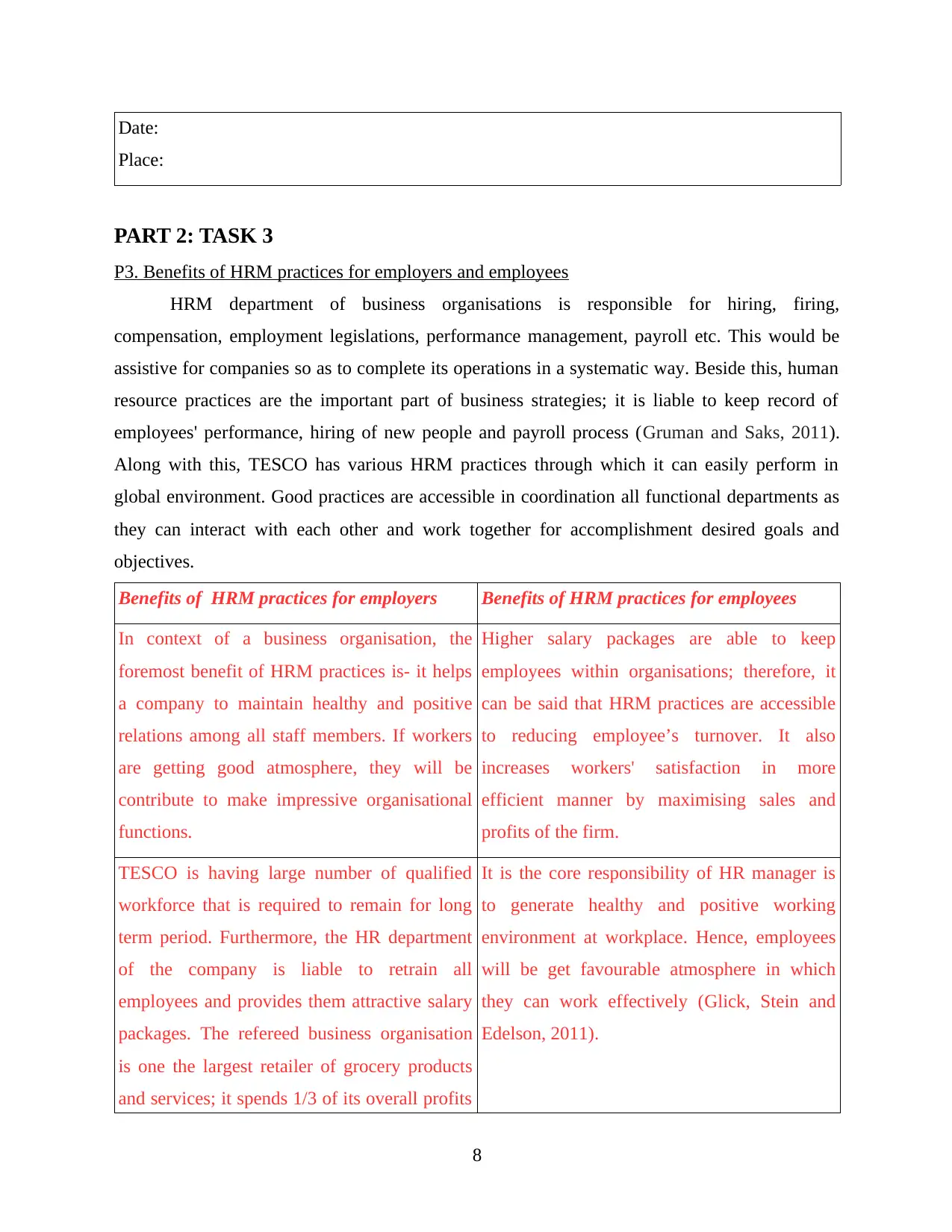
Date:
Place:
PART 2: TASK 3
P3. Benefits of HRM practices for employers and employees
HRM department of business organisations is responsible for hiring, firing,
compensation, employment legislations, performance management, payroll etc. This would be
assistive for companies so as to complete its operations in a systematic way. Beside this, human
resource practices are the important part of business strategies; it is liable to keep record of
employees' performance, hiring of new people and payroll process (Gruman and Saks, 2011).
Along with this, TESCO has various HRM practices through which it can easily perform in
global environment. Good practices are accessible in coordination all functional departments as
they can interact with each other and work together for accomplishment desired goals and
objectives.
Benefits of HRM practices for employers Benefits of HRM practices for employees
In context of a business organisation, the
foremost benefit of HRM practices is- it helps
a company to maintain healthy and positive
relations among all staff members. If workers
are getting good atmosphere, they will be
contribute to make impressive organisational
functions.
Higher salary packages are able to keep
employees within organisations; therefore, it
can be said that HRM practices are accessible
to reducing employee’s turnover. It also
increases workers' satisfaction in more
efficient manner by maximising sales and
profits of the firm.
TESCO is having large number of qualified
workforce that is required to remain for long
term period. Furthermore, the HR department
of the company is liable to retrain all
employees and provides them attractive salary
packages. The refereed business organisation
is one the largest retailer of grocery products
and services; it spends 1/3 of its overall profits
It is the core responsibility of HR manager is
to generate healthy and positive working
environment at workplace. Hence, employees
will be get favourable atmosphere in which
they can work effectively (Glick, Stein and
Edelson, 2011).
8
Place:
PART 2: TASK 3
P3. Benefits of HRM practices for employers and employees
HRM department of business organisations is responsible for hiring, firing,
compensation, employment legislations, performance management, payroll etc. This would be
assistive for companies so as to complete its operations in a systematic way. Beside this, human
resource practices are the important part of business strategies; it is liable to keep record of
employees' performance, hiring of new people and payroll process (Gruman and Saks, 2011).
Along with this, TESCO has various HRM practices through which it can easily perform in
global environment. Good practices are accessible in coordination all functional departments as
they can interact with each other and work together for accomplishment desired goals and
objectives.
Benefits of HRM practices for employers Benefits of HRM practices for employees
In context of a business organisation, the
foremost benefit of HRM practices is- it helps
a company to maintain healthy and positive
relations among all staff members. If workers
are getting good atmosphere, they will be
contribute to make impressive organisational
functions.
Higher salary packages are able to keep
employees within organisations; therefore, it
can be said that HRM practices are accessible
to reducing employee’s turnover. It also
increases workers' satisfaction in more
efficient manner by maximising sales and
profits of the firm.
TESCO is having large number of qualified
workforce that is required to remain for long
term period. Furthermore, the HR department
of the company is liable to retrain all
employees and provides them attractive salary
packages. The refereed business organisation
is one the largest retailer of grocery products
and services; it spends 1/3 of its overall profits
It is the core responsibility of HR manager is
to generate healthy and positive working
environment at workplace. Hence, employees
will be get favourable atmosphere in which
they can work effectively (Glick, Stein and
Edelson, 2011).
8
Paraphrase This Document
Need a fresh take? Get an instant paraphrase of this document with our AI Paraphraser
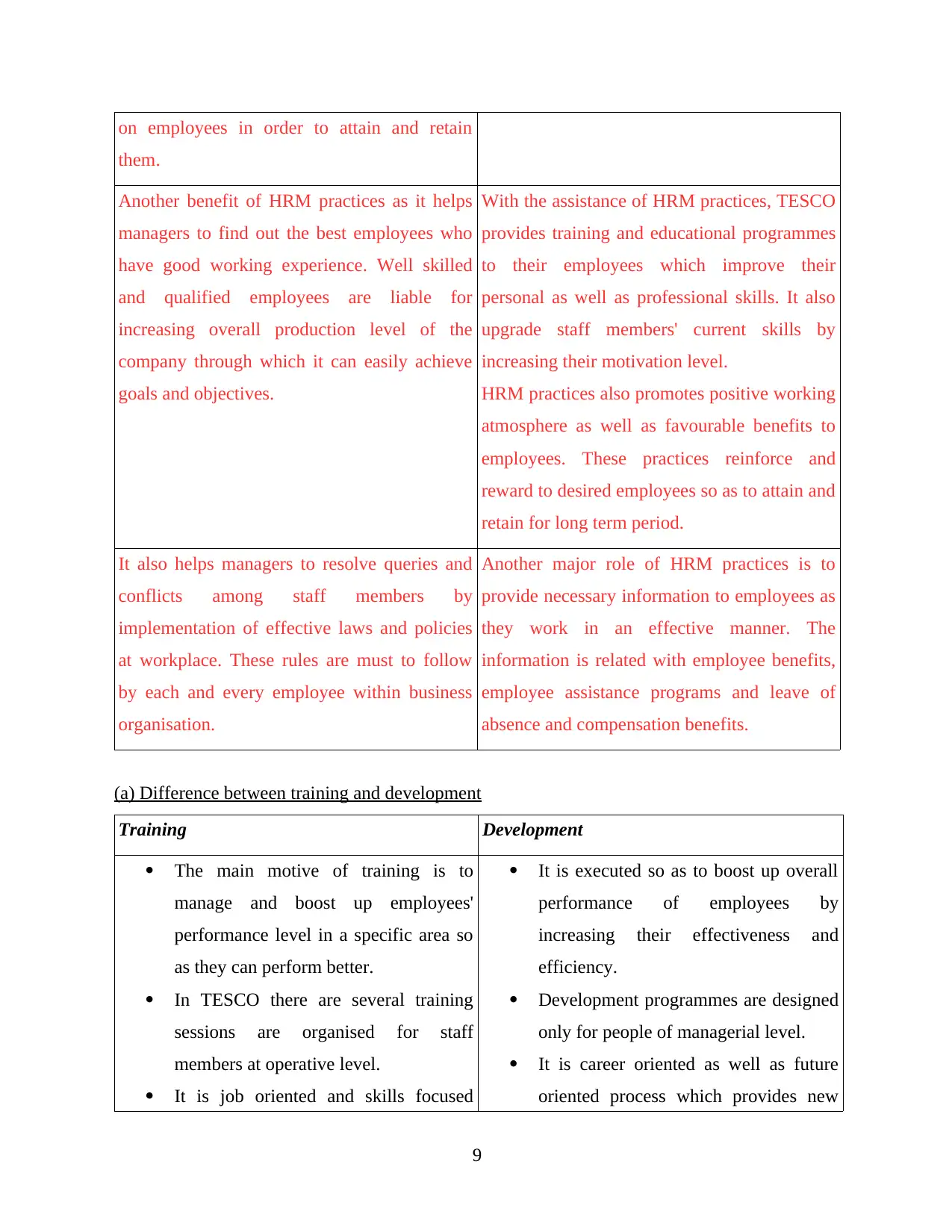
on employees in order to attain and retain
them.
Another benefit of HRM practices as it helps
managers to find out the best employees who
have good working experience. Well skilled
and qualified employees are liable for
increasing overall production level of the
company through which it can easily achieve
goals and objectives.
With the assistance of HRM practices, TESCO
provides training and educational programmes
to their employees which improve their
personal as well as professional skills. It also
upgrade staff members' current skills by
increasing their motivation level.
HRM practices also promotes positive working
atmosphere as well as favourable benefits to
employees. These practices reinforce and
reward to desired employees so as to attain and
retain for long term period.
It also helps managers to resolve queries and
conflicts among staff members by
implementation of effective laws and policies
at workplace. These rules are must to follow
by each and every employee within business
organisation.
Another major role of HRM practices is to
provide necessary information to employees as
they work in an effective manner. The
information is related with employee benefits,
employee assistance programs and leave of
absence and compensation benefits.
(a) Difference between training and development
Training Development
The main motive of training is to
manage and boost up employees'
performance level in a specific area so
as they can perform better.
In TESCO there are several training
sessions are organised for staff
members at operative level.
It is job oriented and skills focused
It is executed so as to boost up overall
performance of employees by
increasing their effectiveness and
efficiency.
Development programmes are designed
only for people of managerial level.
It is career oriented as well as future
oriented process which provides new
9
them.
Another benefit of HRM practices as it helps
managers to find out the best employees who
have good working experience. Well skilled
and qualified employees are liable for
increasing overall production level of the
company through which it can easily achieve
goals and objectives.
With the assistance of HRM practices, TESCO
provides training and educational programmes
to their employees which improve their
personal as well as professional skills. It also
upgrade staff members' current skills by
increasing their motivation level.
HRM practices also promotes positive working
atmosphere as well as favourable benefits to
employees. These practices reinforce and
reward to desired employees so as to attain and
retain for long term period.
It also helps managers to resolve queries and
conflicts among staff members by
implementation of effective laws and policies
at workplace. These rules are must to follow
by each and every employee within business
organisation.
Another major role of HRM practices is to
provide necessary information to employees as
they work in an effective manner. The
information is related with employee benefits,
employee assistance programs and leave of
absence and compensation benefits.
(a) Difference between training and development
Training Development
The main motive of training is to
manage and boost up employees'
performance level in a specific area so
as they can perform better.
In TESCO there are several training
sessions are organised for staff
members at operative level.
It is job oriented and skills focused
It is executed so as to boost up overall
performance of employees by
increasing their effectiveness and
efficiency.
Development programmes are designed
only for people of managerial level.
It is career oriented as well as future
oriented process which provides new
9
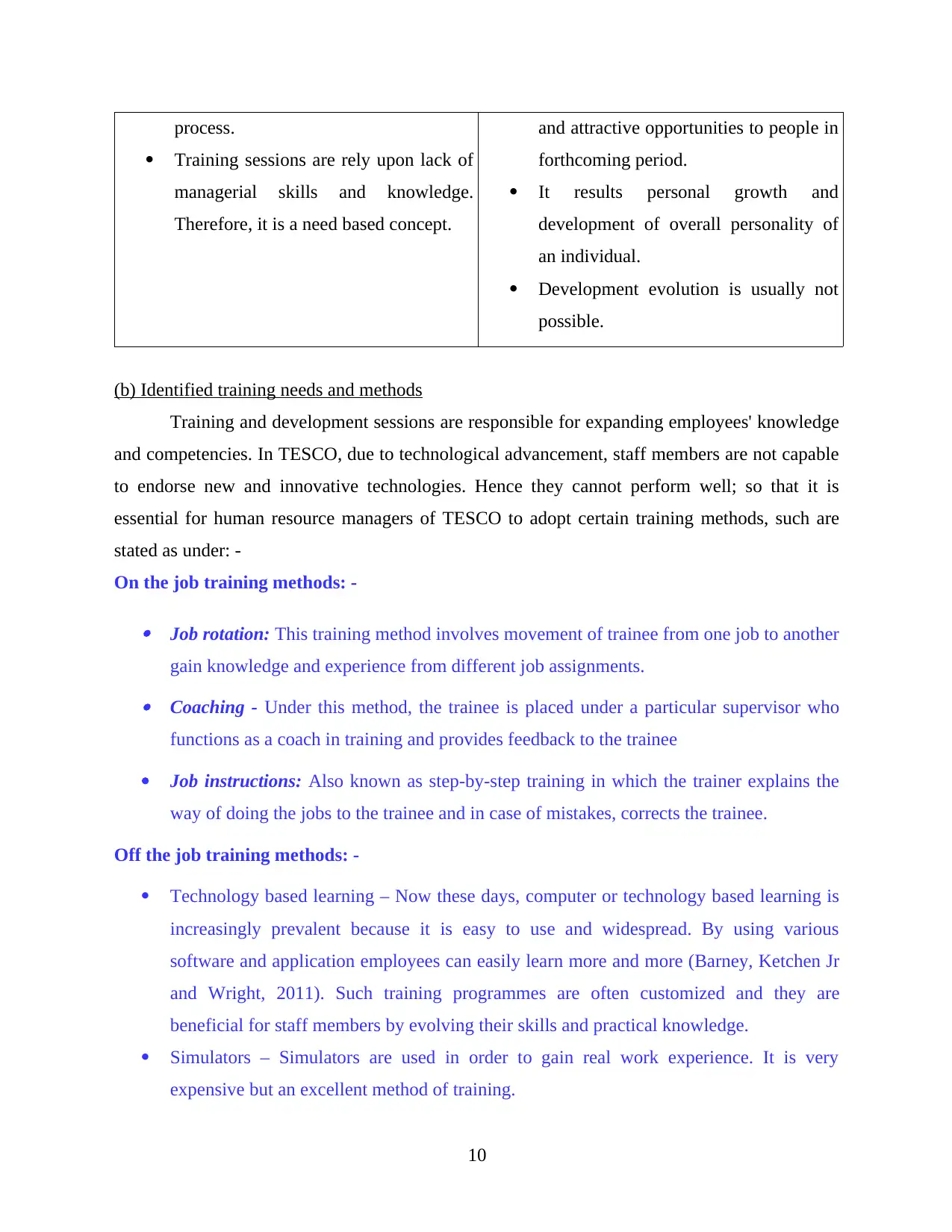
process.
Training sessions are rely upon lack of
managerial skills and knowledge.
Therefore, it is a need based concept.
and attractive opportunities to people in
forthcoming period.
It results personal growth and
development of overall personality of
an individual.
Development evolution is usually not
possible.
(b) Identified training needs and methods
Training and development sessions are responsible for expanding employees' knowledge
and competencies. In TESCO, due to technological advancement, staff members are not capable
to endorse new and innovative technologies. Hence they cannot perform well; so that it is
essential for human resource managers of TESCO to adopt certain training methods, such are
stated as under: -
On the job training methods: -
Job rotation: This training method involves movement of trainee from one job to another
gain knowledge and experience from different job assignments. Coaching - Under this method, the trainee is placed under a particular supervisor who
functions as a coach in training and provides feedback to the trainee
Job instructions: Also known as step-by-step training in which the trainer explains the
way of doing the jobs to the trainee and in case of mistakes, corrects the trainee.
Off the job training methods: -
Technology based learning – Now these days, computer or technology based learning is
increasingly prevalent because it is easy to use and widespread. By using various
software and application employees can easily learn more and more (Barney, Ketchen Jr
and Wright, 2011). Such training programmes are often customized and they are
beneficial for staff members by evolving their skills and practical knowledge.
Simulators – Simulators are used in order to gain real work experience. It is very
expensive but an excellent method of training.
10
Training sessions are rely upon lack of
managerial skills and knowledge.
Therefore, it is a need based concept.
and attractive opportunities to people in
forthcoming period.
It results personal growth and
development of overall personality of
an individual.
Development evolution is usually not
possible.
(b) Identified training needs and methods
Training and development sessions are responsible for expanding employees' knowledge
and competencies. In TESCO, due to technological advancement, staff members are not capable
to endorse new and innovative technologies. Hence they cannot perform well; so that it is
essential for human resource managers of TESCO to adopt certain training methods, such are
stated as under: -
On the job training methods: -
Job rotation: This training method involves movement of trainee from one job to another
gain knowledge and experience from different job assignments. Coaching - Under this method, the trainee is placed under a particular supervisor who
functions as a coach in training and provides feedback to the trainee
Job instructions: Also known as step-by-step training in which the trainer explains the
way of doing the jobs to the trainee and in case of mistakes, corrects the trainee.
Off the job training methods: -
Technology based learning – Now these days, computer or technology based learning is
increasingly prevalent because it is easy to use and widespread. By using various
software and application employees can easily learn more and more (Barney, Ketchen Jr
and Wright, 2011). Such training programmes are often customized and they are
beneficial for staff members by evolving their skills and practical knowledge.
Simulators – Simulators are used in order to gain real work experience. It is very
expensive but an excellent method of training.
10
⊘ This is a preview!⊘
Do you want full access?
Subscribe today to unlock all pages.

Trusted by 1+ million students worldwide
1 out of 19
Related Documents
Your All-in-One AI-Powered Toolkit for Academic Success.
+13062052269
info@desklib.com
Available 24*7 on WhatsApp / Email
![[object Object]](/_next/static/media/star-bottom.7253800d.svg)
Unlock your academic potential
Copyright © 2020–2025 A2Z Services. All Rights Reserved. Developed and managed by ZUCOL.





